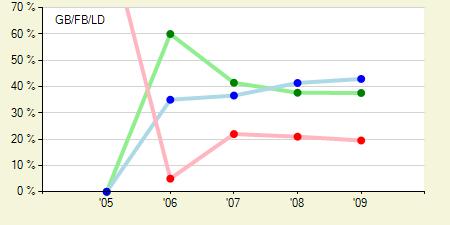Earlier this year, resident ubermensch Dave Cameron submitted for the Reader’s consideration a piece in which he introduced another of FanGraphs’s cutting-edge metrics — namely, Hyperbole Index. Hyperbole Index, or HI, took the world of baseball analysis by storm*, leaving breathless readers of all descriptions, from ESPN Senior Writer Rob Neyer to cunning linguist Snoop Dogg (the latter of whom gushed, “That’s shit’s off the hizzy!”).
*Denotes possible use of hyperbole.
Because I try to have as few original thoughts as possible throughout the day, I’ve opted, in this space, to ride the frig out of Dave’s equally well-pressed and metaphorical coat-tails and share with the Wide Readership some very experimental metrics on which I’ve been working as part of my contribution to FanGraphs’ Department of Advanced Statistickery.
Two notes before I unveil said metrics.
First is that it’s important to recognize that the stats which follow are very much in the development stage and therefore lack the precision and accuracy of a finished product. Much like the Master Painters of yore, I’m only ever involved in the conception of a new stat. The grunt work I pass long to my apprentice statisticians, whose responsibility it is to f a whole bunch with Excel and crap.
Second, I’d like what follows to serve as a bit of a repost to certain readers who’ve called into question the empirical rigor of my first couple-few submissions to FanGraphs. While most readers have been supportive, there are some — and here I’m thinking particularly of user PlayOnWords at D-Rays Bay, who suggested that I’m “turtlenecking”* FanGraphs — there are those who would break that most important of commandments, “Let a player play.” I believe the following work will serve as a giant “Booyah” to those critics.
*Which, if I were to do that to FanGraphs, I’d at least have the decency to buy it dinner and stuff first.
Here now are five metrics on which I’ve been working:
Stat
Douche Factor
For Short
DF
What It Measures
Probable douchey-ness of a player, expressed as a percentage from 0% (very probably NOT a douche) to 100% (almost definitely a douche).
How It’s Calculated
While I’m still experimenting with the degree to which they ought to be weighted, I’ve identified, by means of extensive testing and research, what the main components of the metric are.
 DF considers the three following components:
DF considers the three following components:
1. Stupid Jewelry Factor — In which the number of Phiten-brand “energy necklaces” is considered.
2. Facial Hair Factor — In which the of facial hair is considered. In most cases, the goatee is douchey. Clay Zavada is merely comical and is not penalized.
3. Eye to Jaw Ratio — In which the distance between the eyes is weighed against the distance across of the jaw. Close-together eyes paired with wide-set jaw denoted probably douchey-ness.
Probable League Leaders
Chris Britton (see photo)
Joba Chamberlain
Brad Penny
***
Stat
Whiffle League Equivalents
For Short
WLEs
What It Measures
While a lot of work has been done to assess how minor league performance might be predictive of future major league performance (see: MLEs), very little has been done to investigate how minor or major league production might translate to wiffleball. As you can imagine, the wiffleball lobby isn’t happy about this one bit, and have recently made it their business to harass Yours Truly. Not that I can blame them. As an avid wiffleballista myself, I’m shock-and-awed at the degree to which wiffleball’s place in history has been ignored.
How It’s Calculated
I don’t care, just do it.
Probable League Leaders
This guy.
***
Stat
WOPS
For Short
WOPS
What It Measures
Contrary to what the Reader might think initially, WOPS isn’t Weighted OPS or Walks-plus-OPS or anything involving OPS at all. Rather, WOPS is an attempt to measure the relative Italian-osity of major/minor leaguers. If you don’t get immediately how hilarious this is, click here.
How It’s Calculated
By dividing the the total number of letters in a player’s name by the number of vowels. The closer the result is to 1, the higher the WOPS.
Also, by going to a player’s house/apartment and seeing if his couches have plastic on them.
Also, by considering the model year of the player’s Camaro.
Probable League Leaders
Mike Napoli
Silvio Berlusconi
Val Pascucci
***
Stat
Total Recall Bases
For Short
TRB
What It Measures
No idea, actually. It’s just I thought it might be possible to do some promotional tie-in work with the film of the same name. I’ll have my people call someone else’s people.
How It’s Calculated
Dollar signs.
Probable League Leaders
Give me money.
***
Stat
Enthusiast Quotient
For Short
EQ
What It Measures
The degree to which a player either (a) has warmed or (b) is likely to warm the cockles of the Enthusiast’s heart.
How It’s Calculated
Sir Philip Sidney once quothed*, in re the ideal writing process: “Look into thy heart and write!” To calculate EQ, you do pretty much the same thing, except instead of “write” at the end, instead you “assign a number with which you feel comfortable.”
*Which, that’s the only way people used to speak, I’m pretty sure.
Probable League Leaders
Mark Bellhorn
Jeremy Hellickson
Charlie Haeger







 DF considers the three following components:
DF considers the three following components: